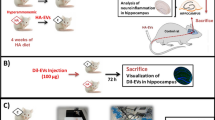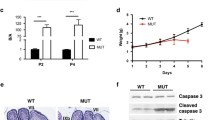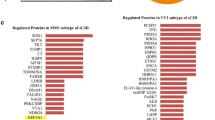Abstract
Hepatic encephalopathy (HE) is a neurological disease associated with hepatic dysfunction. Current knowledge suggests that hyperammonemia, related to liver failure, is a main factor contributing to the cerebral alterations in HE and that hyperammonemia might impair signal transduction associated with post-translational modification of proteins such as tyrosine-nitration and phosphorylation. However, the molecular bases of the HE remain unclear and very little is known about the occurrence of post-translational modification on in vivo proteins. In this exploratory study we look for evidence of post-translation modifications of proteins in the cerebellum of experimental HE rat models using a proteomic approach. For the first time we showed that hyperammonemia without liver failure (HA rats) and experimental HE with liver failure due to portacaval shunt (PCS rats) lead to a reduced protein nitration in rat cerebellum, where the undernitrated proteins were involved in energy metabolism and cytoskeleton remodelling. Moreover we showed that tyrosine nitration loss of these proteins was not necessarily associated to a change in their phosphorylation state as result of the disease. Interestingly the rat cerebellum phosphoproteome was mainly perturbed in PCS rats, whereas HA rats did not shown appreciable changes in their phosphoprotein profile. Since the protein nitration level decreased similarly in the cerebellum of both HA and PCS rats, this implies that the two disease models share common effects but also present some differential signalling effects in the cerebellum of the same animals. This study highlights the interest for studying the concerted action of multiple signalling pathways in HE development.





Similar content being viewed by others
References
Ahl B, Weissenborn K, van den Hoff J, Fischer-Wasels D, Kostler H, Hecker H, Burchert W (2004) Regional differences in cerebral blood flow and cerebral ammonia metabolism in patients with cirrhosis. Hepatology 40:73–79
Azorin I, Minana MD, Felipo V, Grisolia S (1989) A simple animal model of hyperammonemia. Hepatology 10:311–314
Bradshaw RA, Medzihradszky KF, Chalkley RJ (2010) Protein PTMs: post-translational modifications or pesky trouble makers? J Mass Spectrom 45:1095–1097
Carpi D, Korkalainen M, Airoldi L, Fanelli R, Hakansson H, Muhonen V, Tuukkanen J, Viluksela M, Pastorelli R (2009) Dioxin-sensitive proteins in differentiating osteoblasts: effects on bone formation in vitro. Toxicol Sci 108:330–343
Cauli O, Llansola M, Erceg S, Felipo V (2006) Hypolocomotion in rats with chronic liver failure is due to increased glutamate and activation of metabotropic glutamate receptors in substantia nigra. J Hepatol 45:654–661
Cauli O, Rodrigo R, Llansola M, Montoliu C, Monfort P, Piedrafita B, El Mlili N, Boix J, Agusti A, Felipo V (2009) Glutamatergic and gabaergic neurotransmission and neuronal circuits in hepatic encephalopathy. Metab Brain Dis 24:69–80
Chen BS, Roche KW (2009) Growth factor-dependent trafficking of cerebellar NMDA receptors via protein kinase B/Akt phosphorylation of NR2C. Neuron 62:471–478
Cingolani LA, Goda Y (2008) Actin in action: the interplay between the actin cytoskeleton and synaptic efficacy. Nat Rev Neurosci 9:344–356
Cole AR, Causeret F, Yadirgi G, Hastie CJ, McLauchlan H, McManus EJ, Hernandez F, Eickholt BJ, Nikolic M, Sutherland C (2006) Distinct priming kinases contribute to differential regulation of collapsin response mediator proteins by glycogen synthase kinase-3 in vivo. J Biol Chem 281:16591–16598
Corbalan R, Chatauret N, Behrends S, Butterworth RF, Felipo V (2002) Region selective alterations of soluble guanylate cyclase content and modulation in brain of cirrhotic patients. Hepatology 36:1155–1162
Duncan MW (2003) A review of approaches to the analysis of 3-nitrotyrosine. Amino Acids 25:351–361
Earnest S, Khokhlatchev A, Albanesi JP, Barylko B (1996) Phosphorylation of dynamin by ERK2 inhibits the dynamin-microtubule interaction. FEBS Lett 396:62–66
El-Mlili N, Rodrigo R, Naghizadeh B, Cauli O, Felipo V (2008) Chronic hyperammonemia reduces the activity of neuronal nitric oxide synthase in cerebellum by altering its localization and increasing its phosphorylation by calcium-calmodulin kinase II. J Neurochem 106:1440–1449
Erceg S, Monfort P, Hernandez-Viadel M, Llansola M, Montoliu C, Felipo V (2005) Restoration of learning ability in hyperammonemic rats by increasing extracellular cGMP in brain. Brain Res 1036:115–121
Felipo V, Butterworth RF (2002) Neurobiology of ammonia. Prog Neurobiol 67:259–279
Felipo V, Minana MD, Grisolia S (1988) Long-term ingestion of ammonium increases acetylglutamate and urea levels without affecting the amount of carbamoyl-phosphate synthase. Eur J Biochem 176:567–571
Felipo V, Grau E, Minana MD, Grisolia S (1993) Hyperammonemia decreases protein-kinase-C-dependent phosphorylation of microtubule-associated protein 2 and increases its binding to tubulin. Eur J Biochem 214:243–249
Giordano G, Sanchez-Perez AM, Montoliu C, Berezney R, Malyavantham K, Costa LG, Calvete JJ, Felipo V (2005) Activation of NMDA receptors induces protein kinase A-mediated phosphorylation and degradation of matrin 3. Blocking these effects prevents NMDA-induced neuronal death. J Neurochem 94:808–818
Gorg B, Qvartskhava N, Bidmon HJ, Palomero-Gallagher N, Kircheis G, Zilles K, Haussinger D (2010) Oxidative stress markers in the brain of patients with cirrhosis and hepatic encephalopathy. Hepatology 52:256–265
Gururaj A, Barnes CJ, Vadlamudi RK, Kumar R (2004) Regulation of phosphoglucomutase 1 phosphorylation and activity by a signaling kinase. Oncogene 23:8118–8127
Haussinger D, Schliess F (2005) Astrocyte swelling and protein tyrosine nitration in hepatic encephalopathy. Neurochem Int 47:64–70
Haussinger D, Schliess F (2008) Pathogenetic mechanisms of hepatic encephalopathy. Gut 57:1156–1165
Haussinger D, Kircheis G, Fischer R, Schliess F, vom Dahl S (2000) Hepatic encephalopathy in chronic liver disease: a clinical manifestation of astrocyte swelling and low-grade cerebral edema? J Hepatol 32:1035–1038
Haussinger D, Gorg B, Reinehr R, Schliess F (2005) Protein tyrosine nitration in hyperammonemia and hepatic encephalopathy. Metab Brain Dis 20:285–294
Hawkins RA, Mans AM (1993) Brain metabolism in hepatic encephalopathy and hyperammonemia. Adv Exp Med Biol 341:13–19
Hazell AS, Butterworth RF (1999) Hepatic encephalopathy: an update of pathophysiologic mechanisms. Proc Soc Exp Biol Med 222:99–112
Hermenegildo C, Montoliu C, Llansola M, Munoz MD, Gaztelu JM, Minana MD, Felipo V (1998) Chronic hyperammonemia impairs the glutamate-nitric oxide-cyclic GMP pathway in cerebellar neurons in culture and in the rat in vivo. Eur J Neurosci 10:3201–3209
Holness MJ, Sugden MC (2003) Regulation of pyruvate dehydrogenase complex activity by reversible phosphorylation. Biochem Soc Trans 31:1143–1151
Hou ST, Jiang SX, Aylsworth A, Ferguson G, Slinn J, Hu H, Leung T, Kappler J, Kaibuchi K (2009) CaMKII phosphorylates collapsin response mediator protein 2 and modulates axonal damage during glutamate excitotoxicity. J Neurochem 111:870–881
Kaneko T, Maeda A, Takefuji M, Aoyama H, Nakayama M, Kawabata S, Kawano Y, Iwamatsu A, Amano M, Kaibuchi K (2005) Rho mediates endocytosis of epidermal growth factor receptor through phosphorylation of endophilin A1 by Rho-kinase. Genes Cells 10:973–987
Kim YS, Choi MY, Kim YH, Jeon BT, Lee DH, Roh GS, Kang SS, Kim HJ, Cho GJ, Choi WS (2010) Protein kinase Cdelta is associated with 14-3-3 phosphorylation in seizure-induced neuronal death. Epilepsy Res 92:30–40
Kimura K, Suzuki H, Nakano Y (1988) Regulation of glutamine synthetase activity by phosphorylation instead of by adenylylation. Biochem Biophys Res Commun 155:1133–1138
Kwon YG, Lee SY, Choi Y, Greengard P, Nairn AC (1997) Cell cycle-dependent phosphorylation of mammalian protein phosphatase 1 by cdc2 kinase. Proc Natl Acad Sci U S A 94:2168–2173
Lee SH, Fisher B (1961) Portacaval shunt in the rat. Surgery 50:668–672
Liaudet L, Vassalli G, Pacher P (2009) Role of peroxynitrite in the redox regulation of cell signal transduction pathways. Front Biosci 14:4809–4814
Llansola M, Erceg S, Felipo V (2005) Chronic exposure to ammonia alters the modulation of phosphorylation of microtubule-associated protein 2 by metabotropic glutamate receptors 1 and 5 in cerebellar neurons in culture. Neuroscience 133:185–191
Lockwood AH, Yap EW, Rhoades HM, Wong WH (1991) Altered cerebral blood flow and glucose metabolism in patients with liver disease and minimal encephalopathy. J Cereb Blood Flow Metab 11:331–336
Lopez CJ, Qayyum I, Mishra OP, Delivoria-Papadopoulos M (2005) Effect of nitration on protein tyrosine phosphatase and protein phosphatase activity in neuronal cell membranes of newborn piglets. Neurosci Lett 386:78–81
Mallozzi C, Ceccarini M, Camerini S, Macchia G, Crescenzi M, Petrucci TC, Di Stasi AM (2009) Peroxynitrite induces tyrosine residue modifications in synaptophysin C-terminal domain, affecting its interaction with src. J Neurochem 111:859–869
Minetti M, Mallozzi C, Di Stasi AM (2002) Peroxynitrite activates kinases of the src family and upregulates tyrosine phosphorylation signaling. Free Radic Biol Med 33:744–754
Mizutani A, Kuroda Y, Futatsugi A, Furuichi T, Mikoshiba K (2008) Phosphorylation of Homer3 by calcium/calmodulin-dependent kinase II regulates a coupling state of its target molecules in Purkinje cells. J Neurosci 28:5369–5382
Monfort P, Kosenko E, Erceg S, Canales JJ, Felipo V (2002) Molecular mechanism of acute ammonia toxicity: role of NMDA receptors. Neurochem Int 41:95–102
Monfort P, Erceg S, Piedrafita B, Llansola M, Felipo V (2007) Chronic liver failure in rats impairs glutamatergic synaptic transmission and long-term potentiation in hippocampus and learning ability. Eur J Neurosci 25:2103–2111
Monteiro HP (2002) Signal transduction by protein tyrosine nitration: competition or cooperation with tyrosine phosphorylation-dependent signaling events? Free Radic Biol Med 33:765–773
Monteiro HP, Arai RJ, Travassos LR (2008) Protein tyrosine phosphorylation and protein tyrosine nitration in redox signaling. Antioxid Redox Signal 10:843–889
Morishita W, Connor JH, Xia H, Quinlan EM, Shenolikar S, Malenka RC (2001) Regulation of synaptic strength by protein phosphatase 1. Neuron 32:1133–1148
Niwa R, Nagata-Ohashi K, Takeichi M, Mizuno K, Uemura T (2002) Control of actin reorganization by Slingshot, a family of phosphatases that dephosphorylate ADF/cofilin. Cell 108:233–246
Pastorelli R, Carpi D, Campagna R, Airoldi L, Pohjanvirta R, Viluksela M, Hakansson H, Boutros PC, Moffat ID, Okey AB, Fanelli R (2006) Differential expression profiling of the hepatic proteome in a rat model of dioxin resistance: correlation with genomic and transcriptomic analyses. Mol Cell Proteomics 5:882–894
Ponticos M, Lu QL, Morgan JE, Hardie DG, Partridge TA, Carling D (1998) Dual regulation of the AMP-activated protein kinase provides a novel mechanism for the control of creatine kinase in skeletal muscle. EMBO J 17:1688–1699
Quest AF, Soldati T, Hemmer W, Perriard JC, Eppenberger HM, Wallimann T (1990) Phosphorylation of chicken brain-type creatine kinase affects a physiologically important kinetic parameter and gives rise to protein microheterogeneity in vivo. FEBS Lett 269:457–464
Rao KV, Norenberg MD (2001) Cerebral energy metabolism in hepatic encephalopathy and hyperammonemia. Metab Brain Dis 16:67–78
Rodrigo R, Erceg S, Rodriguez-Diaz J, Saez-Valero J, Piedrafita B, Suarez I, Felipo V (2007) Glutamate-induced activation of nitric oxide synthase is impaired in cerebral cortex in vivo in rats with chronic liver failure. J Neurochem 102:51–64
Sanchez-Perez AM, Felipo V (2006) Chronic exposure to ammonia alters basal and NMDA-induced phosphorylation of NMDA receptor-subunit NR1. Neuroscience 140:1239–1244
Schiarea S, Solinas G, Allavena P, Scigliuolo GM, Bagnati R, Fanelli R, Chiabrando C (2010) Secretome analysis of multiple pancreatic cancer cell lines reveals perturbations of key functional networks. J Proteome Res 9:4376–4392
Schliess F, Gorg B, Fischer R, Desjardins P, Bidmon HJ, Herrmann A, Butterworth RF, Zilles K, Haussinger D (2002) Ammonia induces MK-801-sensitive nitration and phosphorylation of protein tyrosine residues in rat astrocytes. FASEB J 16:739–741
Suarez I, Bodega G, Arilla E, Felipo V, Fernandez B (2006) The expression of nNOS, iNOS and nitrotyrosine is increased in the rat cerebral cortex in experimental hepatic encephalopathy. Neuropathol Appl Neurobiol 32:594–604
Vinatier J, Herzog E, Plamont MA, Wojcik SM, Schmidt A, Brose N, Daviet L, El Mestikawy S, Giros B (2006) Interaction between the vesicular glutamate transporter type 1 and endophilin A1, a protein essential for endocytosis. J Neurochem 97:1111–1125
Voglmaier SM, Kam K, Yang H, Fortin DL, Hua Z, Nicoll RA, Edwards RH (2006) Distinct endocytic pathways control the rate and extent of synaptic vesicle protein recycling. Neuron 51:71–84
Yoo Y, Ho HJ, Wang C, Guan JL (2010) Tyrosine phosphorylation of cofilin at Y68 by v-Src leads to its degradation through ubiquitin-proteasome pathway. Oncogene 29:263–272
Zhao W, Cavallaro S, Gusev P, Alkon DL (2000) Nonreceptor tyrosine protein kinase pp 60c-src in spatial learning: synapse-specific changes in its gene expression, tyrosine phosphorylation, and protein-protein interactions. Proc Natl Acad Sci U S A 97:8098–8103
Acknowledgement
This work was supported by grants from Ministerio de Ciencia Innovacion (SAF2008-00062, CSD2008-00005) of Spain and from Conselleria de Educacion (ACOMP-2009-025; PROMETEO/2009/027; ACOMP-2010-220) and Conselleria de Sanitat (AP-024/08, AP-092/09; AP-043/10) of Generalitat Valenciana.
Conflict of interest
The authors declare that they have no conflict of interest.
Author information
Authors and Affiliations
Corresponding author
Electronic supplementary materials
Below is the link to the electronic supplementary material.
Table S1
Submission parameters for the identification of nitrated proteins (DOC 39 kb)
Table S2
Submission parameters for the identification of phosphorylated proteins (DOC 39 kb)
Table S3
Proteins and petides identification_nitrated proteins (XLS 82 kb)
Table S4
Proteins and peptides identification_phopshorylated proteins (XLS 72 kb)
Rights and permissions
About this article
Cite this article
Brunelli, L., Campagna, R., Airoldi, L. et al. Exploratory investigation on nitro- and phospho-proteome cerebellum changes in hyperammonemia and hepatic encephalopathy rat models. Metab Brain Dis 27, 37–49 (2012). https://doi.org/10.1007/s11011-011-9268-4
Received:
Accepted:
Published:
Issue Date:
DOI: https://doi.org/10.1007/s11011-011-9268-4




